Return to Monkey Island review
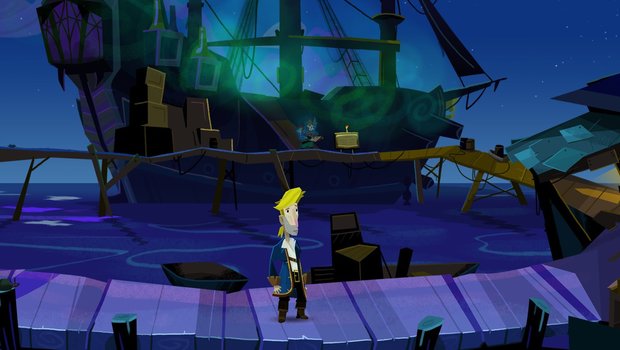
- 4 Comments
A treasured comeback for Ron Gilbert and Dave Grossman
Disclaimer: Return to Monkey Island assumes that you have played the other games in the series, and so will I. There are minor spoilers in this review.
I have a history with Monkey Island. I have played every game in the series at least twice, and all of the classic Monkey Island-isms are the source of a great deal of family in-jokes and imitations. (My brothers and I can insult sword fight much better than even the best-trained dairy farmer.) Each game, with the exception of Escape From Monkey Island, would perhaps fall somewhere in my Top 30 Adventure Games of All-Time-So-Far list, and The Curse of Monkey Island in my Top 10. So I really, really like Monkey Island. But I’m not head over heels in love with Monkey Island, and have no allegiance to any particular era of the storied saga. And since I’m the kind of person who believes that it’s okay for things to end – no further sequels or spin-offs required, thank you – I never ever thought, after finishing the excellent Tales of Monkey Island, “Man, I’d give my left hook and peg leg for another one of these.” Not even one created by the original duo of Ron Gilbert and Dave Grossman.
Which brings us to the brand spanking new Monkey 6, aka Return to Monkey Island. Unlike my own ambivalent self, a lot of people were apparently waiting, opining, drooling, desiring, and generally lusting for this game to happen, for a long, long time. Not only is it a new Monkey Island game, it is also the first one since LeChuck’s Revenge was released over 20 years ago to be created by pretty much the entire original team. Gilbert, Grossman, Fox, McConnell, Bajakian and Land – they’re all back on board, ready to swig some grog, haul some keels, and swash some buckles. Man, what a time to be alive!
Or is it?
If you’ve been following the resurrection of on-again, off-again Captain Guybrush Threepwood’s career with any amount of interest, you’ll know that his latest adventure ran afoul of a small but loud tidal wave of angry fans while en route to its destination. Much ado was made about a new graphical style, and much vitriol was spilled over the way this or that cherished character or location now looked, based only on some screenshots and a short teaser trailer.
Well, after months of waiting, the game has finally reached its port of call. Will we all be taking long walks down short planks to end the misery? Or did the game turn out to be quite a bit of all right, after all – and maybe even good enough to fulfill the wildest wishes of hardcore uberfans who have been waiting all these years for the indisputably official follow-up to Monkey Island 2?
Spoiler alert: It’s mostly the latter.

Return begins exactly where LeChuck’s Revenge left off in legendarily controversial fashion, with an ending that some felt subverted everything that the series had been building towards until that point. The first part of the game is a learn-by-doing introductory chapter, and I really didn’t care for it. Unthinkably – unbelievably! – I found myself not liking the main character. Guybrush might never have been what you could call a good guy, in the heroic sense of the word, but he was always a pleasure to spend time with. This new version of Guybrush, though, is an obnoxious brat. Fans of Nickelodeon’s most juvenile cartoon fare might find something to enjoy here, but I suspect that many players, especially those who grew up with the Monkey Island series, will find playing as him to be a teeth-grinding war of attrition. The experience was unpleasant enough that I reluctantly started thinking ‘Uh-oh … what if they were right about this game after all?’
Thankfully, all panic was all for naught. While the sailing, proverbial and otherwise, is rarely smooth for Guybrush himself, his latest game finds a strong tailwind after the upstream paddle through the introduction. In one swift stroke of brilliance, Return to Monkey Island subverts our expectations yet again, simultaneously validating both the main story of Monkey 2 and its controversial meta-ending as real. Bravo to Terrible Toybox. I only wonder if this is what Mr Gilbert had in mind all along.
Once the intro chapter is over, we find ourselves back in the shoes of likable Guybrush, on the eve of his return to Melee Island. He is obsessed with making a return to Monkey Island, whose secret has continued to elude him all this time. Unfortunately, Guybrush is shipless as usual, and circumstances have made his prospects of procuring a seaworthy vessel even slimmer than his svelte waistline. Helping Guybrush become sea-ready again is the first major obstacle in your quest, a springboard off of which the rest of the story does a dazzling freestyle dive, full of unexpected twists and somersaults, until it sticks a landing that – depending on who you ask – is either even better(!) or even worse(!!) than Monkey 2’s. Along the way, you’ll meet most of the franchise’s classic cast of characters, revisit a few old places, discover a mapful of new ones, and give Murray even more reasons to express his hate for you with his patented brand of cranial demonic spleen.
Just like places you’ll go and the people you’ll meet, the music is a hodgepodge of your favorite old-timey Monkey Island tunes, artfully blended with just as many new ones. As usual, these are mostly subtle but effective mood pieces, which don’t seem to make much of an impression … until they reveal their true ear-wormy nature days later when you find that you can’t stop humming them.

Now it’s time to address the elephantine three-headed monkey in the room that is the contemporary cartoon art style. At worst, it’s fine. At best, it’s excellent, even if it is not what one might have envisioned in their mind’s eye when dreaming about a Monkey Island sequel. While the angular visuals might seem like simplistic and disjointed Saturday morning fare at first blush, seeing them in motion and within context reveals a greater level of nuance and integration. There are reasons one might have reservations about Return to Monkey Island, but basing them entirely on assumptions about the graphics would be cutting off a nose to spite a face that it suits quite well.
The characters, both visually and personality-wise, have been assembled with care and (very often grotesque) detail. The returning cast are as tasty as ever, and if some of the fresh characters are perhaps not as flavorful, it might only be because they haven’t been marinated in decades of nostalgia. (For the record, my two favorite characters in the game are both cooks.) The animations are fluid and plenty, rife with caricaturizing blatancy, and underscored with subtle details. I did experience a couple of instances where character models clipped through one another, which surprised me given the otherwise triple-A quality of the graphics.
The aesthetic splendor of the game’s bloodthirsty denizens is delightfully sublimated by some wonderful voice acting. Over-the-top in a convincing fashion and perfectly cast, the aural personas of almost everyone you meet do just as much to distinguish and endear (or vilify) them to you as their appearances. In most adventures, I end up reading the dialogue text and clicking through the voice-overs before the lines have been completely recited. Not doing that is one of the greatest compliments I can give the voice work and script quality of any game, and that was the case here.
The world through which Return’s vile piratical miscreants rampage is a little less holistically splendid than the miscreants themselves. While some areas, such as the game’s homebase of Melee Island, are fleshed out like a well-fed zombie – overflowing with things to see, flavory and lore-building hotspots to click on, people to help/swindle/irritate/rob/or just plain speak to, and puzzles to solve – others are significantly more skeletal. One entire island in particular has several distinct areas where there is nothing to do, almost nothing to interact with, and nothing particularly special to see that might enhance the island’s atmosphere by showing fragments of its history. Ron Gilbert has stated in interviews that this is the way the islands were always intended to be experienced, but even if that’s true, it seems like content designed to fill these spaces was left on the cutting room floor. It’s not game breaking, but it is a bit of a head-scratcher.

Still, despite the odd vacancies scattered throughout the gameworld, exquisite attention has been paid to every existing element. Return to Monkey Island was clearly an above-and-beyond labor of love for Terrible Toybox, and developer joie de vivre oozes from every gorgeous pore. Each hotspot, of which there are a great many, is a rewarding click. Almost every dialogue option elicits at least a chuckle, and quite often delivers a hearty bellowing piratical har-har-har. This is not a game that one should rush through. Take your time, look around, try everything, talk to everyone, and savor the experience. Terrible Toybox obviously had a lot of hard-working fun making this game fun. It shows, and it pays off.
It’s no secret that, on the whole, newer adventure games have been dumbed down relative to their classic-era counterparts. The Monkey Island games of old are well-known for their tough but usually fair obstacles, and even the more modern Tales was one of the more difficult games that Telltale Games ever designed. I appreciate a stiff challenge and really don’t like pushover games, so my big fear going into Return had nothing to do with the graphics; I was worried that the series’ legacy of fantastic puzzle design would have been neutered to cater to The Modern Audience. The game’s intro chapter, in which you are accompanied by a fellow brat who chatters away constantly with unsolicited solutions to every problem, only exacerbated this fear.
Fortunately, the rest of the game offers a satisfying level of challenge. While by no means as demandingly clever as the toughest stumpers of its older Monkey siblings, there are some very fun conundrums to be solved here, and I found myself stuck just often enough and just long enough each time to feel like I was puzzling my way through and not just following directions. The entertaining and often really, really funny conversations you’ll have with the game’s motley crew do an excellent job of cluing you toward solutions without just giving them away. Even when it’s obvious that a clue is being given, it usually takes a logical step or two before you figure out what to do with it. The difficulty level also ramps up well, so while the game might seem a little easy at first, stick with it and you will be rewarded.
Perhaps the primary reason why Return is easier in its early stages is due to the way it limits your playground to areas that are immediately relevant. There are five chapters in Return to Monkey Island. The first three are enjoyable and engaging, but generally focused and breezy. Things really open up in the fourth chapter, which, in terms of gameplay time and geography, is probably as large as the rest of the game combined. Given the liberty to travel freely among a large variety of areas, it becomes more challenging to figure out where to go, when to go there, and what to do when you go there. Picking at this knot until you’ve accomplished all of your objectives is very satisfying and highly reminiscent of the game’s progenitors.

I should mention that Return, like many previous Monkey Island entries, offers two difficulty levels. I only played the game on Mega Monkey Hard Mode, so I can’t speak for what the puzzles are like on Casual Mode. However, I would encourage even an adventure game newcomer to give it a go on the more challenging difficulty level. You might get held up for a spell by the occasional puzzle, but there’s nothing here that most players won’t be able to overcome with a little head-scratching and perseverance.
If the particulars of all this goodness are a little vague, it’s a testament to the excellent and splendidly surprising story of Return to Monkey Island, which I am loath to spoil even a bit. Along with their cast of returning characters, inside jokes, and comedic instances of impermanent death (among others), a staple of the Monkey Island games has always been Guybrush’s island-hopping antics, in which he sails from one variety of exotic locales to another, leaving a trail of destruction, disorder, or discontent in his wake. Return to Monkey Island continues this tradition wholeheartedly, and the upheaval we get to cause is a franchise high in scope and entertainment value.
While the majority of the game predominantly radiates like freshly minted treasure, there is some fool’s gold that must be excavated as well. Fortunately, these negatives are more akin to being poked with a feather than being tarred and feathered.
The two-button point-and-click controls are generally intuitive, but the navigational possibilities are a little unclear in some areas. On one occasion, this left me stumped for an inordinate amount of time until I figured out that a certain screen could scroll even further upward. Some puzzles in the game are almost guaranteed to require multiple tries, which in and of itself is wonderful. (Good old-fashioned puzzles – hooray!) Having to watch the same unskippable animations over and over again with each attempt to solve them, however, becomes significantly less wonderful with each passing attempt. As an enthusiastic fan of eructation, I never thought I’d write this, but boy am I sick and tired of burping contests.
And speaking of puzzles and repetition, it seems that the true curse of Monkey Island is being haunted by the Ghost of Insult Sword Fighting, and how it created a paradigm wherein each game is supposedly better for having long puzzles that involve fetch-questing dialogue from characters spread all over the world. In Return the curse rears its funny (as usual) but terminally repetitive (as usual) head in the form of a task that requires Guybrush to learn the art of fish-tale telling (these are similar to tall tales, in landlubber speak) so that he can become a high-ranking member of an exclusive club. In order to do this, you must suss out and practice the art of conversation with around a half dozen other members of the club. It’s a good idea that plays out as humorously as you might expect from writers of this caliber, but from a gameplay perspective, it’s unengaging busywork. Had the folks at Terrible Toybox contrived a way to make this part of the game a little more cerebral, it would have been an absolute home run. Instead, its treasure chest full of potential turns out to be only a mixed bag.
Elsewhere, and speaking very generally, metaphorically, and as spoiler-freely as possible, Return’s last series of puzzles make for a delicious pie with a mediocre crust. The first several layers are really good, but when you reach the bottom, where there should be a nice, tasty, satisfying crunch, it turns out to be kind of soggy and bland.
Now, if the divisiveness of Return to Monkey Island’s aesthetics was unintentional, the opposite can almost certainly be said about the game’s denouement. In what I think is a brilliant stroke of narrative coup de grace, the endings – of which several are easily discoverable – bring everything full circle, while once again, just as was done thirty years ago in Monkey Island 2, leave everything open to interpretation. At first I hated it. It upset me so much that I couldn’t stop thinking about it. Then, the more I thought about it, the more I started to like it, until I realized that I wouldn’t rather have it any other way. And you know what? Despite all the waves of controversy and trepidation that it experienced on its way into port, I found this is mostly true of the game as a whole: It could hardly have been more of a joy to play had it been crafted any other way.
Final Verdict
Return to Monkey Island overflows with an abundance of fun, wit, and game design skill that is sharper than Stan’s wardrobe. More importantly, it exudes a passion for the art of designing and the act of playing adventure games like only the best in the genre do. While definitely not above criticism, I believe it behooves every fan of point-and-click adventures – especially those who dig the comedic side – to set aside their expectations and approach the experience with an open mind and open schedule. About 6-8 hours of open schedule, depending on how much dilly-dallying you do. Like a group of adorable swarthy cutthroats earnestly performing their favorite sea shanty, it wants nothing more than to entertain you. And if you let it, you will be.
Hot take
Questions of where it ranks in the series pantheon ought to be irrelevant: Return to Monkey Island is both an excellent adventure game and an excellent Monkey Island game – and that means it’s a treasure.
Pros
- Guybrush and co. are back and they’re as funny as ever
- Voice work is top-notch
- Story is full of surprises, from start to finish
- Puzzles are fun to solve
- Beautiful graphics, even when they’re really gross
Cons
- Intro chapter puts the game’s worst foot forward first
- Some areas are disconcertingly void of things to see and do
- Strong final gameplay sequence ends with a letdown
Michael played his own copy of Return to Monkey Island on PC.


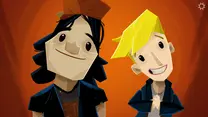

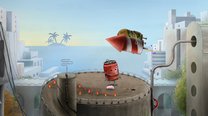

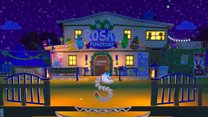

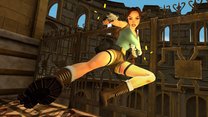

4 Comments
Want to join the discussion? Leave a comment as guest, sign in or register.
This review is what happens if you give the comic book guy a thesaurus for Christmas
Reply
I must confess, he even sent me to the dictionary for "eructation." But hey, if you can't have fun with words when talking about games, what's the point of being a writer?
Reply
The fish-tale telling story is optional on casual mode. I did enjoy it a first time, and it seems like a thesis statement on the games themes, but yeah its a bit of a pain.
Reply
I absolutely Google'd 'burp synonym' for that one. If there are any other fancy or uncommon words in this review, I'm pretty sure it's thanks to a mom who needed a(nother) Scrabble partner when I was 5 years old. She still hasn't let me off the hook with that, either.
Reply
Leave a comment